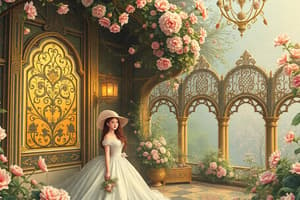Podcast
Questions and Answers
Which of the following is NOT considered a category of arts?
Which of the following is NOT considered a category of arts?
- Visual Arts
- Literary Arts
- Performing Arts
- Culinary Arts (correct)
What is a primary function of the arts that allows for emotional communication?
What is a primary function of the arts that allows for emotional communication?
- Aesthetic Enjoyment
- Therapeutic
- Cultural Reflection
- Expression (correct)
Which art form specifically includes the use of pencils, charcoal, and pastels?
Which art form specifically includes the use of pencils, charcoal, and pastels?
- Drawing (correct)
- Sculpture
- Painting
- Digital Arts
Which art movement is known for its focus on capturing light and its changing qualities?
Which art movement is known for its focus on capturing light and its changing qualities?
Which of the following is NOT a technique used in sculpture?
Which of the following is NOT a technique used in sculpture?
What is the significance of aesthetics in the arts?
What is the significance of aesthetics in the arts?
Which of these artists is known for their work in Surrealism?
Which of these artists is known for their work in Surrealism?
Which current trend in the arts emphasizes sustainability and environmental themes?
Which current trend in the arts emphasizes sustainability and environmental themes?
Flashcards are hidden until you start studying
Study Notes
Definition
- Arts encompass a diverse range of human activities that express creativity and imagination.
Categories of Arts
-
Visual Arts
- Painting
- Sculpture
- Photography
- Drawing
- Printmaking
-
Performing Arts
- Dance
- Theatre
- Music
- Opera
-
Literary Arts
- Poetry
- Fiction
- Non-fiction
- Drama
-
Applied Arts
- Graphic design
- Fashion design
- Industrial design
- Interior design
Functions of Arts
- Expression: Communicates emotions, thoughts, and ideas.
- Cultural Reflection: Mirrors societal values, beliefs, and issues.
- Aesthetic Enjoyment: Provides beauty and pleasure to audiences.
- Therapeutic: Used in healing practices and emotional therapy.
Historical Context
- Arts have evolved through various movements (e.g., Renaissance, Baroque, Modernism).
- Influenced by cultural, political, and technological changes.
Techniques and Mediums
- Drawing: Pencils, charcoal, ink, pastels.
- Painting: Oil, acrylic, watercolor, gouache.
- Sculpture: Clay, stone, metal, wood, mixed media.
- Digital Arts: Computer-generated imagery, animation, graphic design.
Key Concepts
- Aesthetics: Study of beauty and taste in the arts.
- Art Criticism: Analysis and evaluation of art.
- Curation: Selection and organization of artworks for exhibitions.
- Interdisciplinary Art: Combines elements from multiple art forms.
Importance of Arts
- Enhances creativity and critical thinking.
- Promotes cultural understanding and diversity.
- Stimulates economic growth through creative industries.
- Fosters community and social engagement.
Notable Art Movements
- Impressionism
- Expressionism
- Surrealism
- Abstract Expressionism
- Postmodernism
Influential Artists
- Leonardo da Vinci
- Vincent van Gogh
- Pablo Picasso
- Frida Kahlo
- Georgia O'Keeffe
Current Trends
- Digital and interactive art
- Street art and graffiti
- Environmental art and sustainability
- Art in virtual reality and augmented reality spaces.
Definition
- Arts represent a spectrum of human activities that convey creativity and imagination.
Categories of Arts
- Visual Arts: Includes painting, sculpture, photography, drawing, and printmaking.
- Performing Arts: Encompasses dance, theatre, music, and opera.
- Literary Arts: Comprises poetry, fiction, non-fiction, and drama.
- Applied Arts: Features graphic design, fashion design, industrial design, and interior design.
Functions of Arts
- Expression: Serves as a medium for communicating emotions, thoughts, and ideas.
- Cultural Reflection: Acts as a mirror to societal values, beliefs, and contemporary issues.
- Aesthetic Enjoyment: Delivers beauty and pleasure, enriching audience experiences.
- Therapeutic: Plays a role in healing practices and emotional therapy applications.
Historical Context
- Arts have witnessed evolution through prominent movements, such as the Renaissance, Baroque, and Modernism.
- Cultural, political, and technological changes have significantly influenced artistic development.
Techniques and Mediums
- Drawing: Utilizes materials like pencils, charcoal, ink, and pastels.
- Painting: Employs various media, including oil, acrylic, watercolor, and gouache.
- Sculpture: Crafted from clay, stone, metal, wood, and mixed media.
- Digital Arts: Encompasses computer-generated imagery, animation, and graphic design.
Key Concepts
- Aesthetics: Examines the nature of beauty and taste within the arts.
- Art Criticism: Involves the analysis and evaluation process of artworks.
- Curation: Relates to the selection and organization of artworks for exhibitions.
- Interdisciplinary Art: Integrates elements from multiple artistic disciplines.
Importance of Arts
- Boosts creativity and enhances critical thinking abilities.
- Encourages understanding of diverse cultures and promotes inclusivity.
- Catalyzes economic growth via creative industries.
- Fosters community ties and promotes social engagement.
Notable Art Movements
- Key movements include Impressionism, Expressionism, Surrealism, Abstract Expressionism, and Postmodernism.
Influential Artists
- Renowned artists: Leonardo da Vinci, Vincent van Gogh, Pablo Picasso, Frida Kahlo, Georgia O'Keeffe.
Current Trends
- Digital and interactive art gaining prominence.
- Rise in street art and graffiti as forms of expression.
- Growth of environmental art focusing on sustainability.
- Expansion of art in virtual reality and augmented reality environments.
Studying That Suits You
Use AI to generate personalized quizzes and flashcards to suit your learning preferences.




